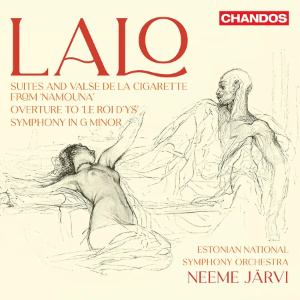
Édouard Lalo (1823-1892)
Overture to Le Roi d’Ys (1875-1888)
Valse de la cigarette from Namouna (1868-1871)
Suite No.1 from Namouna (1868-1871)
Suite No.2 from Namouna (1868-1871
Symphony in G minor (1886)
Estonian National Symphony Orchestra/Neeme Järvi
rec. 2022, Estonia Concert Hall, Tallinn, Estonia
Chandos CHAN20183 [77]
To some, Édouard Lalo is “one work wonder”. To be sure, the Symphonie espagnole is his best-known piece, with dozens of recordings. Those who enjoy exploring rare opera repertoire may well have heard Le Roi d’Ys. It was firstpresented in 1888 at the Opéra-Comique in Paris, and enjoyed success elsewhere in Europe and the United States.
Lalo was born in Lille on 27 January 1823. He studied violin and composition in his hometown and at the Paris Conservatory. In 1848, he was violinist in the Arminaud-Jacquard Quartet, which introduced much Germanic music to France. He seems largely forgotten in the UK, but he enjoyed success with his orchestral and dramatic works. His later life was marred by ill-health and paralysis. He died in Paris on 22 April 1892.
The programme begins with the overture to Le Roi d’Ys. The opera was based on the old Breton legend of a city under the waves – also an inspiration for Claude Debussy’s La cathédrale engloutie. Interestingly, the overture had a performance in 1876, twelve years before the opera. The various themes from the opera include the return of Mylio, the hero, the wicked Margared and the romantic theme of Rozenn. Whether Le Roi d’Ys demands revival is another matter, but the standalone overture deserves its place in the concert repertoire.
The ballet Namouna was premiered at the Paris Opera on 6 March 1882. Lucien Petipa designed the choreography, and devised the libretto along with Charles Nuttier. The backdrop of the ballet is the Isle of Corfu. In a bet with Count Octavio, Lord Adriani loses all his money, his boat and his beloved slave girl Namouna. For better or worse, she falls for the Count, frustrates Adriani’s attempts to get her back, and escapes from the island on a boat. Lalo wrote an introduction and twenty-three numbers. The liner notes tell us that some of these dances “advance the action” while others are simply for dancing. After the initial run of performances, Lalo felt that there was little chance of a revival, so he extracted three suites, and published the first two.
Musically, these “dances” are eclectic. Echoes of different composers find their way into these pages: Grieg, Tchaikovsky, Bizet… Contemporary critics railed against the “Wagnerian” passages, “noisy and intrusive”. It seems pointless to try to extrapolate the plot of the ballet onto the ten movements included here. Besides, the extracts do not follow the order of the story. I guess the listeners will simply enjoy them as standalone creations.
The third suite from Namouna was never published, but the Valse de la cigarette from the first act was issued separately, no doubt in the hope that it would become a potboiler. The “visuals” featured the lead ballet dancer rolling her own cigarette “so she finishes the dance while smoking”. It is an enchanting valse lente.
Lalo only published one symphony, in G minor. I understand that there were/are two unpublished attempts. The present work was premiered in Paris, on 7 February 1887 at the Concerts Lamoureux; the dedicatee, Charles Lamoureux, conducted. The classically constructed symphony has the traditional four movements. The liner notes call attention to the “cyclic” theme used in the “solemn introduction” that recurs at the end of the Adagio and is used to develop material for the finale.
The Scherzo has a typical will o’ the wisp lightness. The trio section is based on a lament from Lalo’s opera Fiesque(The Genoese Conspiracy). Next comes a romantic slow movement, quite beautiful, complete with touches of Wagner. The dance-like finale has a few magical moments of repose. The scoring throughout is masterful. Echoes of Brahms, Schumann and Mendelssohn may be heard. Even so, Lalo’s work stands in its own right. It is neither a parody nor a synthesis of other composers’ music. The symphony can stand proudly beside the contemporaneous works by César Franck and Ernest Chausson, and even Saint-Saëns’s Organ Symphony.
All the works are played with sensitivity balanced by enthusiasm. The recording is excellent. Hugh Macdonald’s liner notes (in English, German and French) give a good introduction to the repertoire. There is a detailed resume of the Estonian National Symphony Orchestra and their conductor in this recording, Neeme Järvi. Their current maestro is Olari Elts.
This is a splendid introduction to the music of Édouard Lalo for those who wish to explore beyond the ubiquitous, brilliant Symphonie espagnole.
John France
Help us financially by purchasing from



















